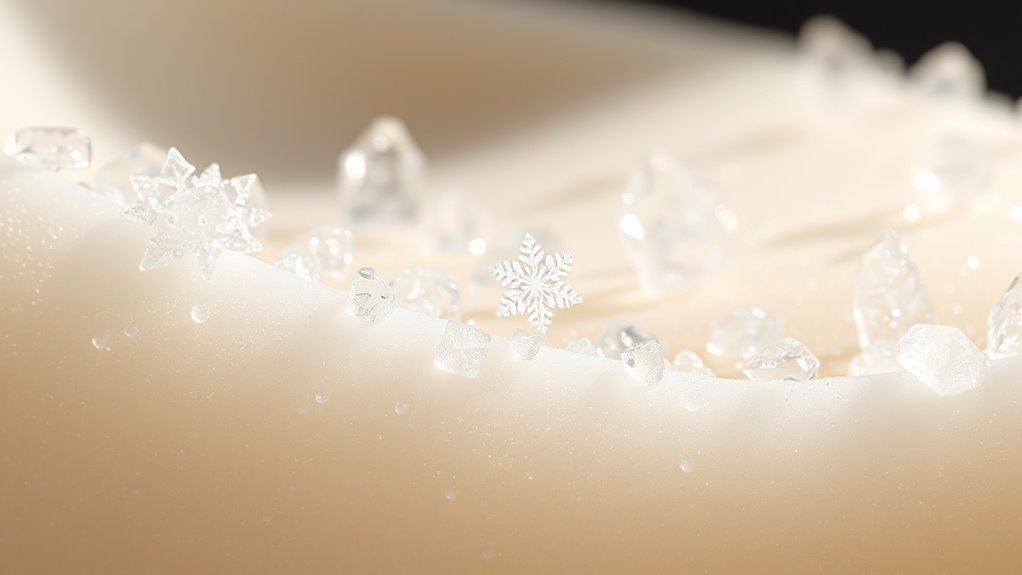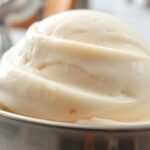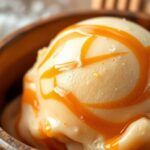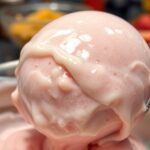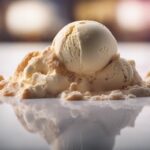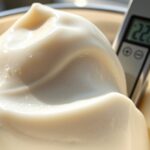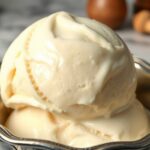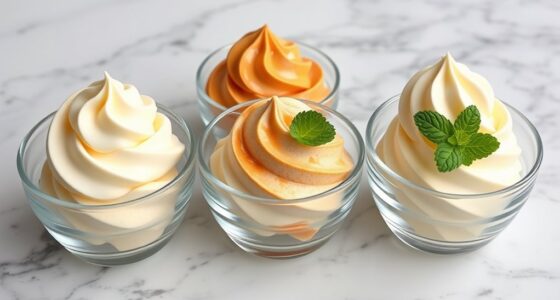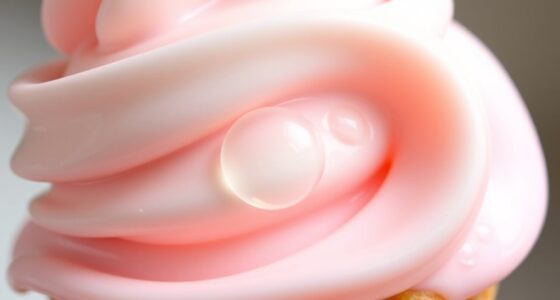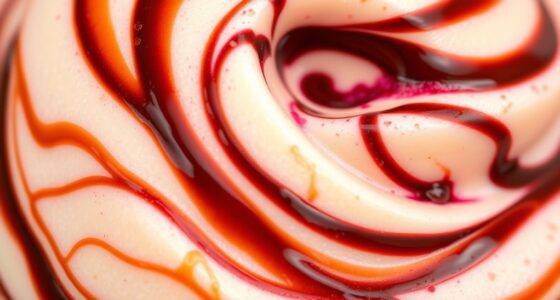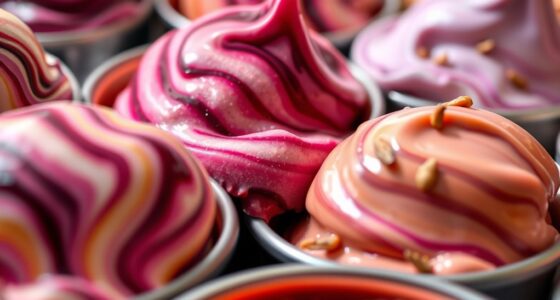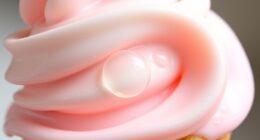To tame ice crystals like a pro, control sugar levels to interfere with water molecules and lower the freezing point, delaying large crystal formation. Keep your mixture cold before freezing and freeze slowly with steady agitation, whether in a commercial machine or a home ice cream maker. Using stabilizers or alcohol can help, too. Patience and proper temperature management are key. Keep these tips in mind, and you’ll reveal the secrets to perfectly smooth, luscious gelato every time.
Key Takeaways
- Incorporate the right amount of sugar to prevent large crystal formation and promote a velvety texture.
- Use continuous agitation during freezing to break up ice crystals and ensure uniform size.
- Lower the mixture’s freezing point through pre-chilling and stabilizers for slower, more controlled crystallization.
- Maintain consistent freezing temperatures and avoid fluctuations to prevent crystal growth.
- Use high-quality equipment or techniques like batch freezers for better control over ice crystal development.
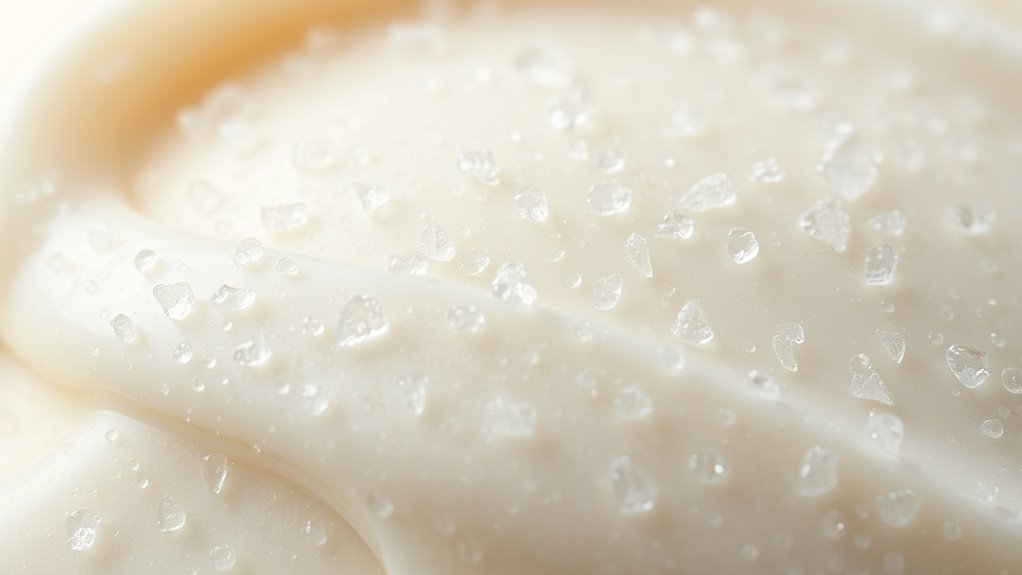
Ice crystals can be a challenge to control, especially when they form unexpectedly or in unwanted places. When making gelato or other frozen treats, the key to achieving that smooth, creamy texture lies in understanding how to manage sugar crystallization and freezing point depression. Sugar plays an essential role in preventing large ice crystal formation because it interferes with water molecules, reducing their ability to form big crystals. By carefully balancing sugar content, you can slow down ice crystal growth, resulting in a velvety texture that’s desirable in high-quality gelato.
Freezing point depression is another fundamental concept to grasp. When you add sugar to your mixture, it lowers the overall freezing point, meaning the liquid stays unfrozen longer during the freezing process. This delay allows for a slower, more controlled crystallization process, which is necessary for a silky finish. If your mixture freezes too quickly, large ice crystals can develop, giving your gelato a grainy or icy feel. To avoid this, aim for gradual freezing, either by using a specialized ice cream machine or by employing techniques that promote slow freezing, such as pre-chilling your mixture thoroughly.
Adding sugar lowers the freezing point, ensuring slow, controlled crystallization for silky gelato.
Controlling ice crystal formation also involves proper mixing techniques. Continuous agitation during freezing prevents the crystals from growing too large. This is why commercial gelato makers often use batch freezers that churn the mixture constantly, ensuring small, uniform crystals. If you’re making gelato at home, using a good quality ice cream maker that agitates the mixture during freezing can make a significant difference. Additionally, adding alcohol or certain stabilizers can further inhibit large crystal formation, as these ingredients lower the freezing point even more and create a barrier against crystal growth.
Temperature control is critical throughout the process. Keep your mixture cold before freezing, as warmer mixtures tend to crystallize faster and form larger crystals. Once in the freezer or ice cream maker, maintain a consistent temperature, avoiding fluctuations that can cause crystals to grow. Covering your container tightly also helps by preventing moisture from entering and causing unwanted crystallization. Remember, patience is key—allow your gelato enough time to freeze slowly and evenly for the best texture.
Furthermore, understanding the science behind sugar crystallization and how it influences ice crystal size can help you fine-tune your process for optimal results. Ultimately, taming ice crystals boils down to understanding the science—using the right amount of sugar, managing freezing point depression, and controlling temperature and agitation. When you master these elements, you’ll produce gelato with a smooth, luscious consistency that rivals professional quality. It’s about working with the science rather than against it, ensuring each batch of frozen treat is perfectly creamy and satisfying.
Frequently Asked Questions
Can Freezing Temperature Fluctuations Affect Ice Crystal Formation?
Temperature fluctuations can definitely impact ice crystal formation. When temperature stability isn’t maintained, freezing consistency suffers, leading to uneven and larger ice crystals. These fluctuations cause the water molecules to melt and refreeze repeatedly, disrupting the smooth texture you want in gelato. To keep your gelato perfect, make certain your freezer maintains a consistent temperature, preventing ice crystals from growing too large and ruining that silky, creamy mouthfeel you’re aiming for.
Does the Size of Ice Crystals Impact Gelato Flavor?
You might notice that larger ice crystals can dull gelato’s aesthetics, making it look less appealing. These crystals can also influence flavor consistency, as they may cause uneven texture and mask delicate flavors. Smaller ice crystals enhance the smooth, creamy mouthfeel and preserve the true flavor profile. So, controlling crystal size not only improves the overall ice crystal aesthetics but also guarantees you enjoy a consistently flavorful, luxurious gelato experience.
Are There Natural Ingredients That Help Prevent Large Ice Crystals?
Imagine your gelato’s texture as a delicate dance. You can help keep ice crystals small by incorporating natural antioxidants like vitamin C or fruit extracts, which act as gentle anti-freeze agents. These ingredients slow down crystal growth, ensuring your gelato remains smooth and luscious. Not only do they enhance flavor, but they also make the freezing process more forgiving, giving you that perfect, velvety bite every time.
How Does Overmixing Influence Ice Crystal Development?
Overmixing can markedly influence ice crystal development, often leading to larger crystals that ruin your gelato’s smooth texture. When you overmix, it introduces more air and causes uneven freezing, which can worsen ice crystal growth. However, gentle, controlled mixing promotes finer crystals and enhances texture improvement. So, keep your mixing just right to prevent large crystals and achieve that perfectly creamy consistency you’re aiming for.
Can Storage Containers Affect the Size of Ice Crystals in Gelato?
Your storage container’s insulation and airtight lid directly influence ice crystal size in gelato. Proper insulation keeps temperature fluctuations minimal, preventing large crystals from forming, while a tight lid preserves moisture and prevents freezer burn. When both are effective, you create a stable environment that maintains smooth texture. So, choose containers with good insulation and airtight lids, ensuring your gelato stays consistently creamy and free of unwanted ice crystals.
Conclusion
Now that you know how to tame those pesky ice crystals, your gelato will have that irresistibly smooth, creamy texture everyone loves. With patience and the right techniques, you can master the art of perfect gelato at home. Are you ready to impress your friends with your frozen desserts? Remember, the key is consistency and attention to detail. So go ahead—get freezer-ready and start creating gelato that’s truly pro-level!
